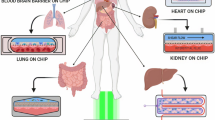Abstract
A microfluidic-based dynamic in vitro model of the human intestinal barrier has been constructed and characterized. The intestinal epithelial monolayer was mimicked by culturing caco-2 cells on a porous membrane in a double-layered microfluidic chip and interfaced with a co-culture of U937 as a model of immune responsive cells. The physiological flow was also mimicked by a continuous perfusion of culture media from the apical and basolateral side of the porous membrane. This dynamic “in vivo-like” environment maintains a continuous supply of cell nutrient and waste removal and create mechanical shear stress within the physiological ranges which promotes uniform cell growth and tight junction formation. The monolayer permeability to soluble ion changes after treating with LPS, and TNF α as indicated by the reduction of the TEER value. In addition, the immune competent caco-2/U937-based model allowed the investigating the role of the epithelial layer as a protection barrier to biological hazards as indicated by the suppressing of the pro-inflammatory cytokine expression.





Similar content being viewed by others
References
L. Ungell, J. Karlsson, in In Drug bioavailability; Estimation of Solubility, Permeability, Absorption and Bioavailability, ed. by H. van de Waterbeemd, H. Lennernas, P. Artursson. (Wiley-VCH 2003), (2003), pp. 90–131
A. Wikman-Larhed, P. Artursson, Eur. J. Pharm. Sci. 3, 171–183 (1995)
C. Halleux, Y.J. Schneider, in Vitro. Cell Dev. Biol, Vol. 27, (1991), pp. 293–302
C. Hilgendorf, H. Spahn-Langguth, C.G. Regårdh, E. Lipka, G.L. Amidon, P. Langguth, J. Pharm. Sci. 89, 63–75 (2000)
D Hollander, C.M. Vadheim, E. Brettholz, G.M. Petersen, T. Delahunty, J.I. Rotter, Ann. Intern. Med. 105, 883–885 (1986)
D. Huh, G.A. Hamilton, D.E. Ingber, Trends Cell. Biol. 21(12), 745–54 (2011)
F. Leonard, E.M. Collnot, C.M. Lehr, Mol. Pharm. 7(6), 2103–2119 (2010)
G. Nollevaux, C. Devillé, B. El Moualij, W. Zorzi, P. Deloyer, Y.J. Schneider, O. Peulen1, G. Dandrifosse, BMC Cell Biol. 7(20) (2006)
G.R. May, L.R. Sutherland, J.B. Meddings, Gastroenterol. 104, 1627–1632 (1993)
H.J. Kim, D. Huh, G. Hamiltonan, D.E. Ingber, Lab Chip. 12, 2165–2174 (2012)
J. Ando, K. Yamamoto, Cardiovasc. Res. 99, 260–268 (2013)
M. Ikenouchi, K. Furuse, H. Furuse, S. Sasaki, S. Tsukita, J. Tsukita, Cell Biol. 171, 939–945 (2005)
J.R. Pappenheimer, Am. J. Physiol. 265, G409–G417 (1993)
K.R. Groschwitz, S.P. Hogan, J. Allergy. Clin. Immunol. 124, 3–20 (2009)
H. Ting, J.R. Jahn, J.I. Jung, B.R. Shuman, S. Feghhi, S.J. Han, M.L. Rodriguez, N.J. Sniadecki, Am. J Physiol. Heart. Circ. Physiol. 302, H2220–H2229 (2012)
L.S. Gan, D.R. Thakker, Adv. Drug Del. Rev. 23, 77–98 (1997)
M. Furuse, K. Fujita, T. Hiragi, S. Tsukita, J. Cell Biol. 141, 1539–1550 (1998)
M.T. Furuse, M. Hirase, M. Itoh, A. Nagafuchi, S. Yonemura, S. Tsukita, S. Tsukita, J. Cell Biol. 123, 1777–1788 (1993)
M. Yazdanian, S.L. Glynn, J.L. Wright, A. Hawi, Pharm. Res. 15, 1490–1494 (1998)
Q. Ramadan, H. Jafarpoorchekab, P. Silacci, S. Carrara, J. Ramsden, G. Vergeres, M.A.M. Gijs, Lab Chip. 13, 196–203 (2013)
M. Brand, T.L. Hannah, C. Muller, Y. Cetin, F.G. Hamel, Ann. Biomed. Eng. 28, 1210–1217 (2000)
C. Resta-Lenert, K.E. Barrett, Ann. N.Y. Acad. Sci. 1165, 175–182 (2009)
S. Guo, R. Al-Sadi, H.M. Said, T.Y. Ma. Am. J. Pathol. 182(2), 375–387 (2013)
W.V. Graham, A.M. Marchiando, L. Shen, J.R. Turner, Ann. N.Y. Acad. Sci. 1165, 314–322 (2009)
Acknowledgments
This research was supported by the Agency for Science, Technology and Research (A*STAR) (Grant number: 1431AFG123).
Author information
Authors and Affiliations
Corresponding author
Rights and permissions
About this article
Cite this article
Ramadan, Q., Jing, L. Characterization of tight junction disruption and immune response modulation in a miniaturized Caco-2/U937 coculture-based in vitro model of the human intestinal barrier. Biomed Microdevices 18, 11 (2016). https://doi.org/10.1007/s10544-016-0035-5
Published:
DOI: https://doi.org/10.1007/s10544-016-0035-5




